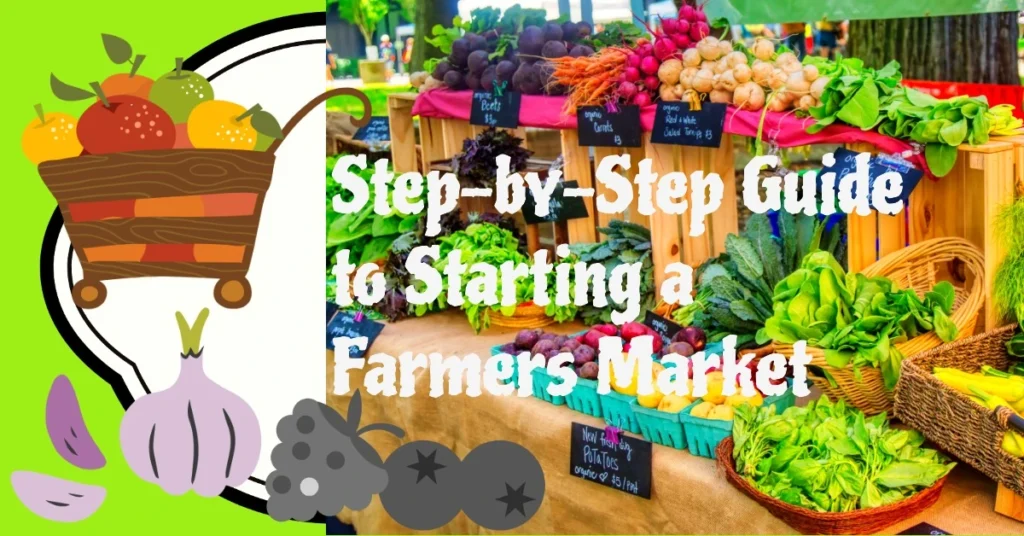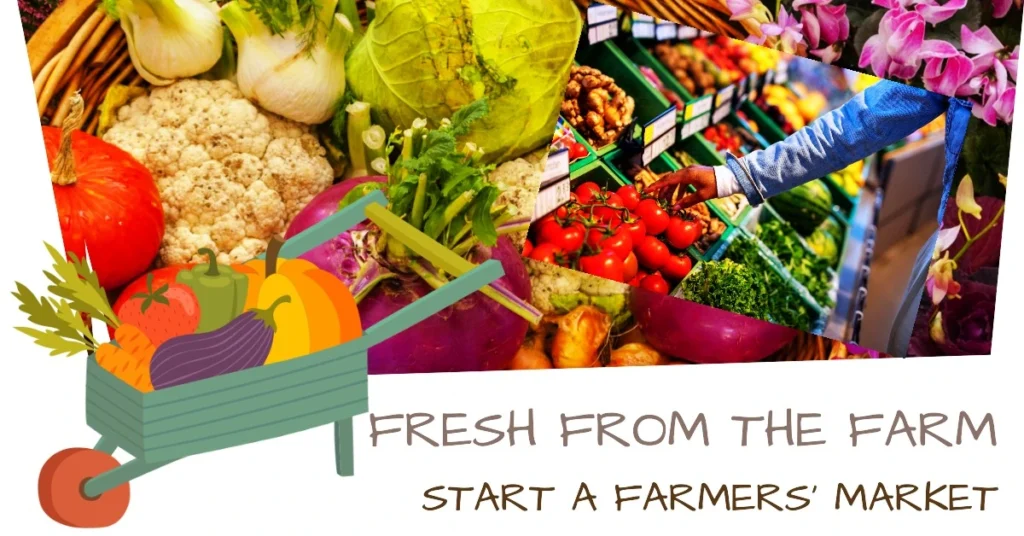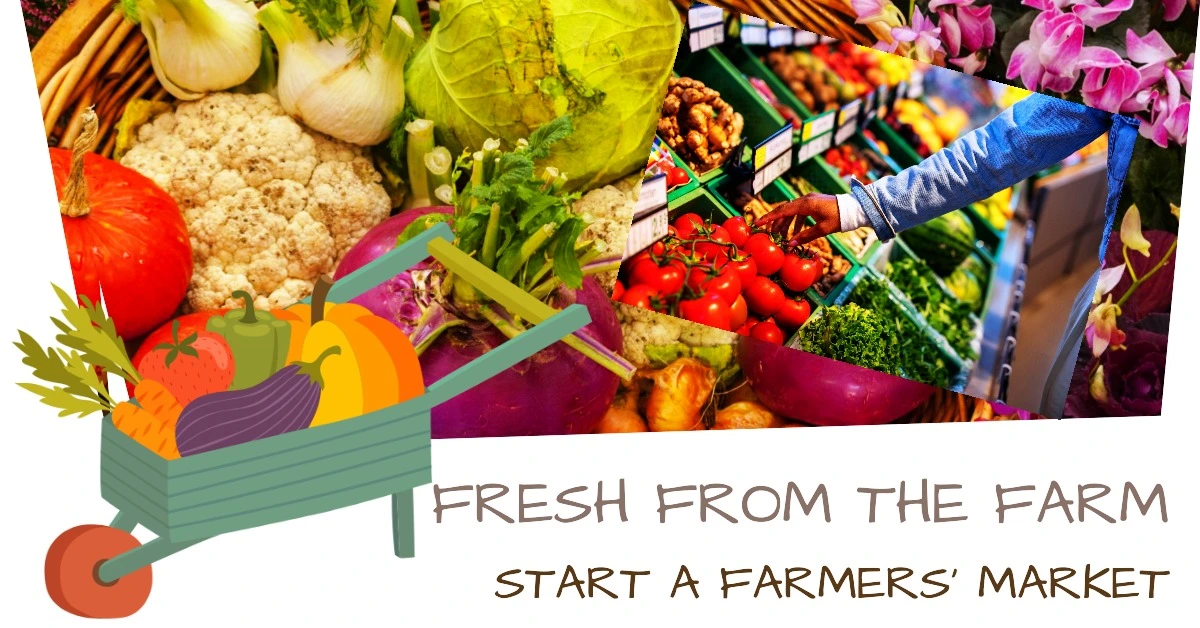Farmers markets serve as vibrant social hubs where fresh, local produce meets the heart of a neighborhood. These markets are not just about buying and selling, they are about bringing fresh, sustainable choices right to the neighborhood’s doorstep.
With their roots in ancient trading traditions, today’s farmer’s markets have flourished, becoming essential community fixtures in urban and rural settings. This article will provide practical guidance on how to start and operate a thriving farmers market in your area.
What is a Farmers Market?
A farmers market is a local setup where farmers sell fresh goods directly to consumers. It’s a place brimming with community spirit, where the produce is just picked and the handmade goods are rich with local charm. These markets are a nod to simpler times, prioritizing face-to-face interactions over commercial transactions.

They are not only about selling food, they are about nurturing community bonds and celebrating locally grown offerings. Here, a diverse spectrum of sellers, from weekend gardeners to seasoned growers, come together with the same objective: to make fresh, wholesome, and locally sourced goods accessible. It’s where the direct marketing of farm-to-table items creates a tapestry of taste and togetherness.
Why Start a Farmers Market?
Starting a new farmers market can provide many advantages for your community. Here are some top reasons to consider opening one:
- Provides sales opportunities for local farmers, crafters, and food entrepreneurs. This gives them a venue to sell their goods directly to neighbors and community members.
- Generates additional income for local producers and stimulates the local economy. Money spent at the market stays in the community.
- Creates a community gathering space that encourages socializing and connections. A market can become a lively hub for the town or city.
- Increases access to fresh, locally grown produce and foods. Markets make it easier for community members to find county health and seasonal goods.
Benefits of Farmers Markets
Operating a farmers’ market can have many positive impacts on a local community:
- Supports and promotes local agriculture. Markets provide essential income for family farms and give farmers a place to sell directly to consumers.
- Contributes to economic vitality. Markets keep money circulating in the local economy and bring foot traffic to nearby businesses.
- Provides access to fresh, nutritious food. Markets in underserved areas can increase the availability of healthy, affordable food options.
- Fosters entrepreneurship. Markets offer a low-cost way for new businesses to launch and test products.
- Cultivates community gathering spaces. Markets become venues for people to interact, share ideas, and cultivate relationships.
- Educates consumers. Interacting directly with farmers and producers educates shoppers on agriculture, food and nutrition services, and the value of locally sourced goods.
- Promotes sustainability. Selling locally reduces transport emissions and supports small-scale, earth-friendly agriculture.
Step-by-Step Guide to Starting a Farmers Market

Conduct Market Research
Performing market research is crucial to assess the viability of a farmers’ market in your area. Here are key aspects that a market manager analyzes:
- Evaluate demand by surveying community interest in a local market. Gauge how many people would shop, vend, or volunteer.
- Research the competition. Are there existing markets nearby? How could yours be differentiated?
- Assess potential vendor interest: survey local farms, crafters, and bakers about participating as sellers.
- Identify optimal schedules based on growing seasons, harvests, and community needs.
- Explore potential sponsors and community partners like hospitals, schools, or non-profits.
Choose a Suitable Location
Selecting the right location is vital for your farmers market’s success. Considerations include:
- Accessibility – a central spot near public transit with parking and foot traffic.
- Facilities – adequate restrooms, water, electricity, and parking.
- Space – enough room for vendor booths and customer circulation.
- Visibility – a location that is noticeable and easily seen.
- Permits – confirm zoning, health codes, business licenses, and insurance.
Contact Regulatory Bodies
To operate legally, connect with the proper authorities and market association early:
- Health department – The market will need permits, and food sampling according to market rules and sanitation guidelines.
- USDA, Department of Agriculture – for certifying producers, inspection protocols.
- Business license bureau – for required licenses, regulations, and tax collection.
- City, county, parks department – for permits to use public spaces and parking lots. Connect with the chamber of commerce for local business insights and potential partnerships.
- Public transit agency – for coordination if the site is near bus or train stops.
Recruit Vendors and Products
A diverse vendor mix creates an appealing market:
- Open vendor recruitment 2-3 months before opening. Promote opportunity through ads, and listings.
- Seek a blend of vendors selling produce, meat, dairy, baked goods, and crafts.
- Prioritize vendors selling locally grown, homemade, home-processed goods.
- Limit prepared food vendors to allow room for producers to add value.
- Assess applications based on product quality, presentation, and growing practices.
Market and Promote Your Farmers Market
Use diverse strategies to attract shoppers and for cooperative extension:
- Create a website, social media, and email newsletter with vendor info and updates.
- Distribute flyers to neighborhood homes, shops, libraries, and community hubs.
- Post on community calendars and get included in local media listings with the help of newspaper ads.
- Partner with community groups, schools, and hospitals on promotions.
- Host fun special events like cooking demos, corn roasts, and contests.
Launch and Manage Operations
Careful planning ensures opening day runs smoothly:
- Create detailed schedules for vendor arrival, set-up, and break-down. Provide volunteers to assist.
- Establish and communicate rules for sanitation, waste, smoking, and pet policies.
- Set up a system to collect vendor dues, and taxes, and process EBT payments. Assign staff to manage.
- Have a process to resolve conflicts about booth placement, noise, or conduct issues. Prioritize communication.
Funding and Financial Management
Explore diverse options to fund and sustain market operations:
- Seek start-up grants from USDA, farmers market organizations, and agriculture departments.
- Partner with community organizations or businesses to sponsor the market.
- Charge vendor participation fees and daily stall rents to cover costs.
- Fundraise through community events like cook-offs, raffles, and donations.
- Develop lean annual budgets. Look for cost-saving opportunities like donated supplies.
Community Engagement
Employ strategies to become a community hub:
- Form a community advisory panel to guide outreach and get feedback.
- Host free educational events on nutrition, gardening, cooking, and sustainability.
- Partner with health organizations, schools, and non-profits on promotions and programs.
- Feature local talent and craftspeople to showcase community skills.
- Offer to gather spaces for socializing to foster connections.
Challenges and Solutions
Prepare proactively to overcome common difficulties:
- Have contingency plans for poor weather, like tents, gravel walkways, and drainage.
- Build reserves and diversify offerings to manage slower Fall/Winter seasons.
- Mitigate conflicts through clear rules, mediation, and communication channels.
- Start small to keep costs manageable. Expand based on sales and interest.
- Market aggressively via ads, promotions, and special events during slower periods.
Frequently Asked Questions – FAQs
Researching your area’s needs, finding a good spot, getting permits, recruiting vendors locally, and spreading the word are key steps to launching a farmers market.
Chat with markets in nearby towns, check your state’s agriculture department guidance, and browse resources from universities or national farmers’ organizations to learn the ropes.
Budgets range depending on size and location, but I’d estimate between $10k-$30k to cover promotion, space rentals, supplies, insurance, and any permit fees.
Careful planning, strong leadership, vendor support, community engagement, promotions, and creating a vibrant gathering space all contribute to a thriving market.
Contact your local health department, business licensing bureau, and other regulators to learn about permit, safety, and operation requirements in your area.
Very strong – with a tripling in numbers over the past 20 years and demand still rising, markets have great potential if they offer value and cultivate community loyalty.
Supporting local vendors, fun events and activities, great products, food education, and a welcoming, lively vibe make a market a true community highlight.
Social media, local radio/print ads, flyers, partnerships, and community event listings help effectively reach nearby residents and spread the word.
Advertising in local farming publications, emphasizing customer volume potential, building relationships in the agriculture community, and understanding vendor needs.

Wrapping Up
Starting a farmers market requires commitment but offers immense community benefits with the essence of local food and camaraderie. It’s a commitment to sustainability and the prosperity of local agriculture. As you step into the role of market organizer, you join a network of strong farmers and artisans, all contributing to a vibrant marketplace.
This guide summarized the initial steps to start a successful farmers market in your community. Crucial actions include choosing a suitable location, recruiting vendors, promoting goods, and fostering community partnerships. Markets can overcome common challenges like weather and sales fluctuations through preparation and adaptability.
With strategic planning and dedication to supporting local producers and bringing neighbors together, you can create a vibrant farmers market. Begin by assessing needs, securing resources, and rallying supporters. Follow the tips outlined to establish your market as a hub for local commerce and community building.
Your market’s success will be measured by the number of vendors who share your vision, the inclusivity of your market directory, and the support of the farmers’ market association. Whether it’s the first market day or the launch of a new farmers’ market, your initiative can become the heartbeat of the community, a place where freshness meets tradition within 24 hours of harvest. With passion and diligence, you can develop a thriving venue that connects your region and drives prosperity.
Muhammad Asif Saeed has extensive experience in commerce and finance. Specifically, He holds a Bachelor of Commerce degree specializing in Accounts and Finance and an MBA focusing on Marketing. These qualifications underpin his understanding of business dynamics and financial strategies.
With an impressive 20-year career in Pakistan’s textile sector, including roles at Masood Textile (MTM) and Sadaqat Limited, excelling in business & financial management. His expertise in financial and business management is further evidenced by his authoritative articles on complex finance and business operation topics for various renowned websites including businessproplanner.com,businesprotips.com,distinctionbetween.com, trueqube.com, and bruitly.com, demonstrating his comprehensive knowledge and professional expertise in the field.


Hello. I will increase traffic and profitability of the site, and also solve all the problems existing on the site. Moreover, the increase in traffic will be due to the influx of targeted visitors from search engines, which is the most profitable and promising for you.
A little information about yourself. I am a specialist in the field of creation, improving and promotion of websites. I also have knowledge and experience in a number of related fields. Work experience is more than 19 years. I always do quality work. Prices are moderate.
The main areas of my activity: creating websites, improving websites and correcting errors, promoting websites in search engines, setting up advertising campaigns in contextual advertising services, various types of mass mailings (they give a good one-time influx of sales), working with reviews on the Internet. I also create, refine and promote groups and channels on social networks (YouTube, Instagram, Telegram, VK and others).
Write to my email: [email protected]
———————-
Здравствуйте. Увеличу посещаемость и доходность сайта, а также решу все имеющиеся на сайте проблемы. Причем рост посещаемости будет идти за счет притока целевых посетителей из поисковых систем, что для вас максимально выгодно и перспективно.
Немного информации о себе. Я являюсь специалистом в области создания, доработки и продвижения сайтов. Также имею знания и опыт в ряде смежных областей. Опыт работы составляет больше 19 лет. Работу всегда выполняю качественно. Цены умеренные.
Основные направления моей деятельности: создание сайтов, улучшение сайтов и исправление ошибок, продвижение сайтов в поисковых системах, настройка рекламных кампаний в сервисах контекстной рекламы, различного рода массовые рассылки (дают хороший единоразовый приток продаж), работа с отзывами в интернете. Также занимаюсь озданием, доработкой и продвижением групп и каналов в социальных сетях (YouTube, Instagram, Telegram, VK и другие).
Пишите на мою почту: [email protected]